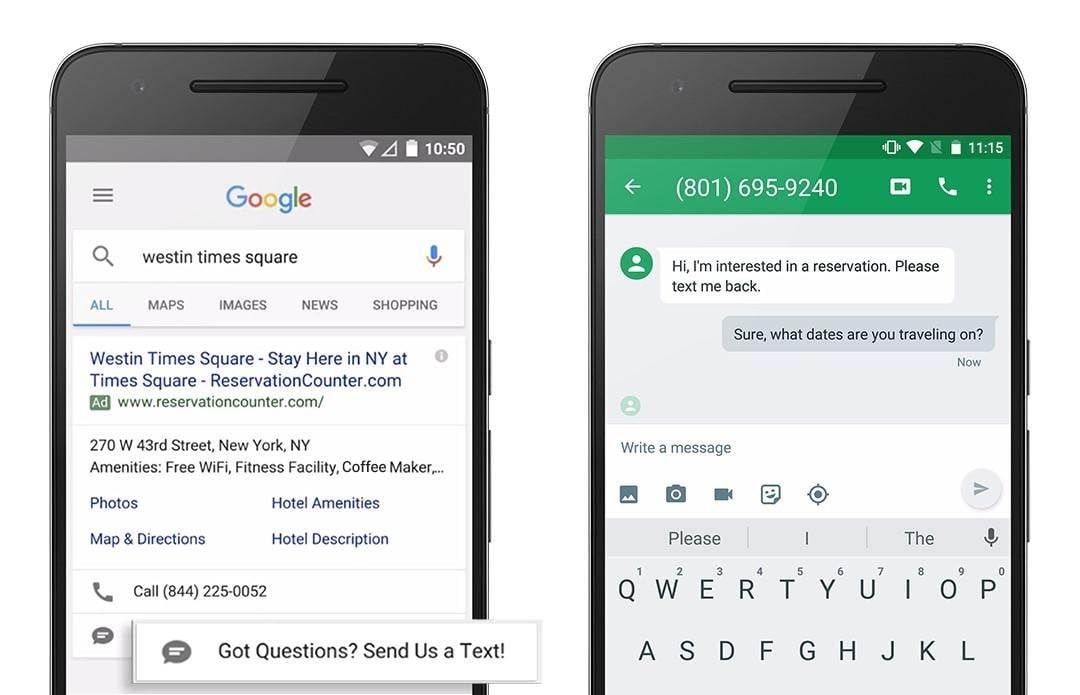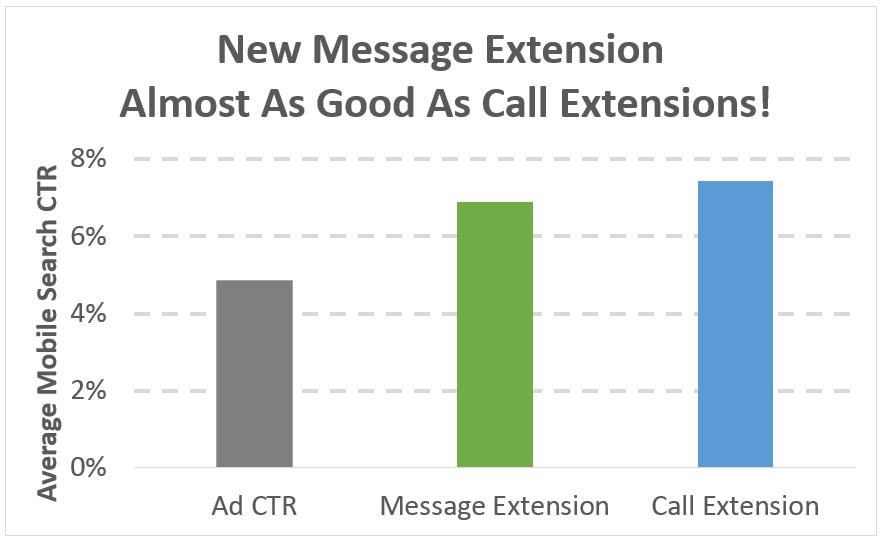
Question: What kind of advertiser doesn’t want their creative to sprawl down and across the entirety of a prospect’s search engine results page?
Answer: A bad one.
And how does one achieve such SERP dominance? Why, through ad extensions, of course!
As most of you are aware, ad extensions are the extra bits of information Google allows advertisers to append to their Expanded Text ads in order to provide more (and more relevant) information to searchers. They don’t take long to set up. They’re displayed at no additional cost. And they turn your paid search ads from this…
Into this…
After a long night of bar hopping and bong rips, which would you click?
Now, ad extensions, while inarguably useful, are not a secret. Your biggest competitors are already using them. They’re probably doing so ineffectively, at the account level (you can get ad group granular with some of these suckers) with bland messaging, but their ads are yolked.
In a world where everyone’s ads are bursting with clickable, informative appendages, how can you differentiate?
By finding more creative ways to leverage ad extensions.
Today, I’m going to suggest three creative, alternative applications for ad extensions designed to help you zig (or zag) while other advertisers walk the straight and narrow. They are:
- The zero-dollar price extension
- The message extension as lead generation
- The daily callout extension
Shall we?
#1: The Zero-Dollar Price Extension
Price extensions are relative newcomers as far as ad extension are concerned, but if you sell something (which, you know, seems pretty likely), they’re an absolute must. Basically, price extensions allow you to call out specific products or services and advertise their associated costs alongside the rest of your ad creative. They look something like this:
As you can see, the price extensions appear below the description section of the ad and link directly to the pages on your website associated with the items you’re highlighting. In addition to the name of a given product and link to its digital home, you’re also afforded the opportunity to select a category (header), a price qualifier (like “from” or “up to”) and a short description. As far as ad extensions go, these are among the most information-rich in your arsenal.
Initially, these suckers were only available on mobile devices which made them really useful for ecommerce operations and simple lead generation but significantly less so for those selling something a bit more nuanced like, say, online advertising software. Since then, however, price extensions have been rolled out across all devices, making them an invaluable tool for all advertisers, especially those trying to give something away for “free.”
Yup, you read that right.
If your top of funnel goal isn’t a sale but, rather, to introduce your business to prospects using free tools or gated content (white papers, infographics, etc.), you can leverage price extensions to highlight multiple offerings, improving your chance of converting. For example, we use price extensions to hammer home the fact that our AdWords Performance Grader is free (twice) and offer prospects the opportunity to begin a free trial of WordStream Advisor or check out our revamped Free Keyword Tool:
Instead of simply using sitelink extensions with descriptions that mention the fact that these offers cost nothing, we make use of the almighty dollar (or total lack thereof).
While using individual ads that use the headlines and description to promote the most relevant tool based on keyword is still the optimum strategy, providing additional free options via price extensions is going to a) take up more SERP real estate, b) turn heads, and c) expose prospects to the wealth of value your brand can provide (without forking over a dime).
If your business has a multi-touch sales process and can provide value to prospects who aren’t quite ready to make a purchase, set up zero-dollar price extensions. You’ll make a helluva first impression, you’ll bolster brand equity, and you can remarket to those same prospects (who now have an affinity for your business) with an offer that inspires credit card to escape wallets with gusto.
#2: Message Extensions as Lead Generation
Google, being an omnipresent force and all, understands people spend a ludicrous amount of time on their phones. I’m going to go out on a limb here and say they also know that most everyone with a smartphone prefers to engage with others using their thumbs instead of their mouths and ears.
Enter message extensions, which give prospects on their phones the ability to reach advertisers via SMS instead of having to make a call.
Instead asking a prospect in need to navigate to your website or click your call extension, a message extension allows them to engage with someone from your business via text. You can even include a pre-written message to kick the conversation off immediately, ensuring a prospect doesn’t bounce back to their browser in search of a more immediate solution. The best part? Clicks on message extensions cost the exact same as anywhere else on your ad: you have a direct line to a prospect actively searching for a solution at the same cost as a form fill. That’s fire, son.
Now, these things are pretty damn effective when used for their intended purpose. Way back when they were in Beta, our own Mark Irvine deduced that message extensions have a CTR that rivals call extensions:
Pretty neat, right? The only real issue with message extensions is the complete lack of conversion tracking. While you can text your prospects, you can’t track or associate value with those conversations within Google Ads (formerly known as AdWords).
And now for the creative application: use message extensions as a form of lead generation. Not to answer questions, but to get prospects on the phone while they’re actively seeking information about your product or service. There’s no hotter lead!
If you’ve got a sales team (or you are your sales team) and a prospect texts you through an AdWords ad, you’ve got an immediate entry point into a constructive conversation. Simply call said prospect, using a combination of the keyword they found you through and their inquiry as an icebreaker. This’ll allow you to get as much value out of an informational or transactional searcher as possible.
Now, you’re not going to want to implement this system across the board. Some keywords are too top of funnel (lacking intent) to warrant a phone call.
This is where a well thought out account structure comes into play. In tertiary campaigns (broad keywords), you can probably avoid message extensions all together. In informational campaigns, you should use them for their intended purpose: to respond to questions via text message. But when it comes to high-intent, high value keywords and/or branded keywords, get your prospects on the phone.
To ensure that you don’t squander the opportunities presented by message extensions, make sure you implement scheduling that reflects your business hours: you’re a hard worker, but everybody’s gotta sleep sometime!
#3: Daily Callout Extensions
While price and message extensions are relatively new and their use is less widespread, callout extensions are a staple of most every Google Ads account. If you’re not familiar with them, here’s what they look like in the wild:
As you can see, their use is straightforward: to provide quick-hits of supporting information about your business, product, or service. Many advertisers implement them at the account level and use them generally. This is totally fine. Additional SERP real estate and useful information is better than an ETA flying solo.
But since when was Google Ads about anything but granularity?
Instead of using broad, sweeping callout extensions that speak about your business in general terms, try implementing a daily rotation.
Check this out:
By simply adding the day of the week to their booking-related callout extensions, this hotel saw CTRs jump almost an entire percentage point. If you’re a plumber looking to book more jobs, why not try adding the day of the week (or simply rotating different callout extensions daily) and seeing how it impacts ad performance? Even an ecommerce advertiser can use this technique: if you know your products ship within two days, on Tuesdays run a callout extension that says, “Get Your Widget By Thursday.” The only thing people love more than free stuff are immediacy and personalization: why not give ‘em both?
Final Thoughts
Extensions are a fantastic way to improve your ad performance when you use them as Google intended. But by thinking outside of the box a bit, you can do a lot more than push your competitors further down the results page: you can acquire more new business, too.
















